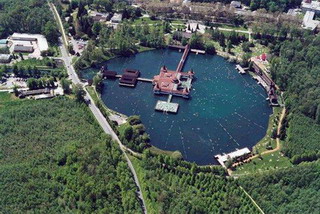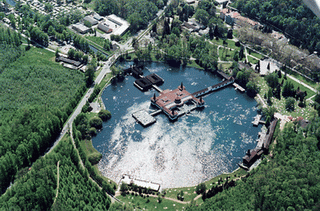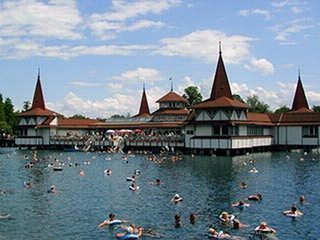
In the course of history the various nations coming to the Balaton Uplands all left their traces in Hévíz and in this area. The archeological excavations carried out in the year 2001 produced very important results in the Egregydistrict of Hévíz. The finds attest that this area was permanently inhabited for seven millenia, from the middle of the new stone-age (end of the 6th century B.C.) until the Carolingian era right before the Hungarian conquest (9th century A.D.). The most significant find, the Roman villa with a corridor measuring nearly one thousand square metres which also had central heating, dates back to the early period of the Roman empire. The executive board of the town of Hévíz is planning to display the ruins of the building and a part of the finds. The "Roman grave" in Egregy and the altar-stone sacred to Jupiter that was found next to the Margaret-villa near the lake of Hévíz date back to the late period of the Roman empire. On the basis of the finds mentioned above we can assume that the Romans already knew Hévíz and its healing power and this was the force that attracted the owners of the Roman villas here. Besides all these, the water of the lake was also used for industrial purposes - hemp, flax and leather works.

After the Hungarian conquest, during the centuries of the early Middle Ages there were several villages named Páh in this area, such as Bor-páh (the present day Alsópáhok) or Szentandrás-páh (later Hévízszentandrás) which refer to the professions of the inhabitants of the time.
The name of Hévíz was first mentioned in a charter that dates back to 28th March 1328 in which the Chapter of Veszprém inaugurated Pál Magyar as the reeve of Gimes into his estate called Szentandrás-páh. A place, commonly called hévíz (thermal waters), was also mentioned when a description was made about the boundaries of the estate ("ad locum vulgariter heuvyz dictum"). In the charter a huge marsh by the name of Hosszúsár, which was fed by the warm water flowing freely out of the lake, was also registered. According to linguists, the word 'hévíz' means "flowing, warm spring" in Hungarian and this word was used in the same sense in the Middle Ages as well. No documents were found from the centuries of the Middle Ages that would indicate that the water of the lake in Hévíz was used for curing, however, the possibility cannot be precluded for thermal waters were popular during the Turkish occupation of Hungary especially among soldiers who often suffered from gout. The thermal waters hiding among the reeds and sedges of the marsh were used for occasional bathing by people living in this region. Documents from the 17th century gave an account of the drainage work in the valley of Hévíz in connection with the building of mills, which shows the utilization of the outflowing water.

During the 18th century the lake of Hévíz became well-known and at the end of the century Hévízfürdo was established. In 1731 Mátyás Bél, one of the best known polymaths of the contemporary Hungary visited this area and in his report he gave a relatively detailed account of his experiences. The first scientific analysis and publication on the water of the springlake was performed by Ferenc Szláby, the chief medical officer and physicist of Zala county in 1769.
Near the end of the century the lake of Hévíz was already marked in some maps. In the map of the first military survey from 1783 ordered by Joseph II the lake of Hévíz was called "a warm, sulphurous lake" and the rill which was operating several mills was called "Hévíz Brook". Later the brook was called "warmrill" while the expression 'Hévíz' was only used for the lake itself. The name of Hévíz appeared in print for the first time in 1780 in Károly Windisch's German-speaking work titled Gottlieb. ("The Geography of the Hungarian Kingdom"). Hévíz was also mentioned in the Hungarian historical-geographical dictionary published in 1786 and written by Mátyás János Korabinszky. In the 18th century the value of the valley of Hévíz was given by the mills and the excellent hay yield in some places. In the last decade of the century the utilization of the healing water came into the limelight, the rediscovery of which and the establishment of the spa are György Festetics's achievements.
The possibility of major developments was provided by the land consolidation of 1857 and 1958 and by the exchange contract between the Bishopric of Veszprém and Count Tasziló Festetics. Due to the latter, the estate obtained an area suitable for constructions where the so-called 'Új-telep' (New Colony) was built. Till 1871 seven houses were built near the lake. The so-called 'Hetes ház' (The Seventh House) still stands today. Due to the constructions the spa became a more and more significant and frequently visited place. The Festetics family let the spa out on lease for shorter or longer periods at the turn of the century. Thanks to Sándor Lovassy, an academical teacher of economics in Keszthely, water-lilies from India were planted in the lake in 1898. The flowers are still a famous sight of Hévíz. In 1905 Vencel Reischl, a brewery owner in Keszthely leased the territory from the Festetics family for 35 years, which proved to be a great stimulus for the development of the lake of Hévíz.

Between the two world wars the significance of Hévíz was increasing: since after the Peace Treaty of Trianon lots of spas were disannexed from Hungary, Hévíz became the most important spa of Hungary. The constructions continued around the lake: a lido was built in 1926 and the next year a multi-storied bath house on the northern shore of the lake. In 1931-1932 the building of the bath house got a glass-roofing attached to an iron construction, thus it became totally enclosed. The construction of big holiday centres started in the middle of the 1920s. There were 110 cubicles on the lake at the take-over in 1905 and their number rose to 680 by 1930, including cubicles where 150 people could change their clothes at the same time. The number of the rooms was 74 at the health resort in 1905 while it amounted to 250 in 1939.
Further developments could not be carried out because of the war period and the unstable political atmosphere following it, not to mention the problems arising by the fact that the Festetics family, the owner of the estate, left the country. During the war years visitors came exclusively from Germany. Lots of wounded soldiers were cured in the spa between 1944 and 1945. Hévízfürdo was nationalized in 1948 and in the following years the catering establishments were also taken into public ownership. The Hévíz Public Spa Hospital was established by the Ministry of Health on 1st January 1952. Hévíz became the biggest spa in the country where patients were treated for rheumatic diseases. The Spa Hospital was enlarged and modernized in the 1960s and new streets and parks were built in 1965. This was the year when the bus station, which is still used today, was built.
Hévíz was given the status of an incorporated municipality on 1st January 1970. Visitors arrived mainly from Hungary and from the Eastern European countries. At the end of the 1970s 80 percent of the visitors were Hungarians. In the 1970s the trade union holiday centres were renovated one after the other. In the middle of the 1980s the number of the guests from Western Europe noticeably increased. Private accommodation services became more and more important. The renovation of the spa started in the middle of the 1970s - the modernization and winterizing took almost a decade. In March 1986 the spa's central building made of wood caught fire and its biggest part burnt down. More than years were needed for the complete renovation. The problems of Hévíz checked the growth of tourism by 20 perccent in the second part of the 1980s. Naturally, the political changes in 1989 and 1990 caused radical changes in Hévíz as well. Due to the lack of solvent demand, the number of the guests from Hungary and Eastern Europe decreased. Parallel with this, the number and proportion of guests from the West, particularly from the German-speaking areas, significantly increased. After the privatization a considerable part of the trade union holiday centres were converted into modern and well-equipped hotels. In the 1990s the development was bigger than ever before. Hotels and other catering establishments were built one after the other by Hungarian and foreign investors.
Hévíz gained municipal status on 1st May 1992. Its first secondary school, the István Bibó Secondary Grammar School was established next year. By the middle of the 1990s Hévíz become a regional centre offering more and more services and programmes. In the second part of the decade several churches were built in Hévíz. The new sports centre and the modern, large town hall were inaugurated in September 1999. At the beginning of the 21st century Hévíz is one of the most popular and dinamically developing spas in Hungary visited by guests all year round.
After the archaeological excavations, in 2004 the Town of Hévíz established a Roman ruins park in the area with the help of the Ministry of National Cultural Heritage.
In 2004 the Town of Hévíz had the chance to become one of the founders of the Hévíz Spa and St. Andrew Rheumatology Hospital Public Utility Company, with a 74% participation of the Hungarian state. The former institution was operated independently of the management of the town, so development intentions, which were formed in accordance with the guests' requirements, could not be supported by local sources. The Public Utility Company, which manages the state-owned spa and its establishments, is a pioneer of dynamic changes. The full reconstruction of the building complex of the Hévíz spa started in the summer of 2005. As a result of the two-year-long renovation, a therapeutic and recreational centre offering a wide range of services at European standards is going to be built on the largest spa of the world which is suitable for direct bathing.
|